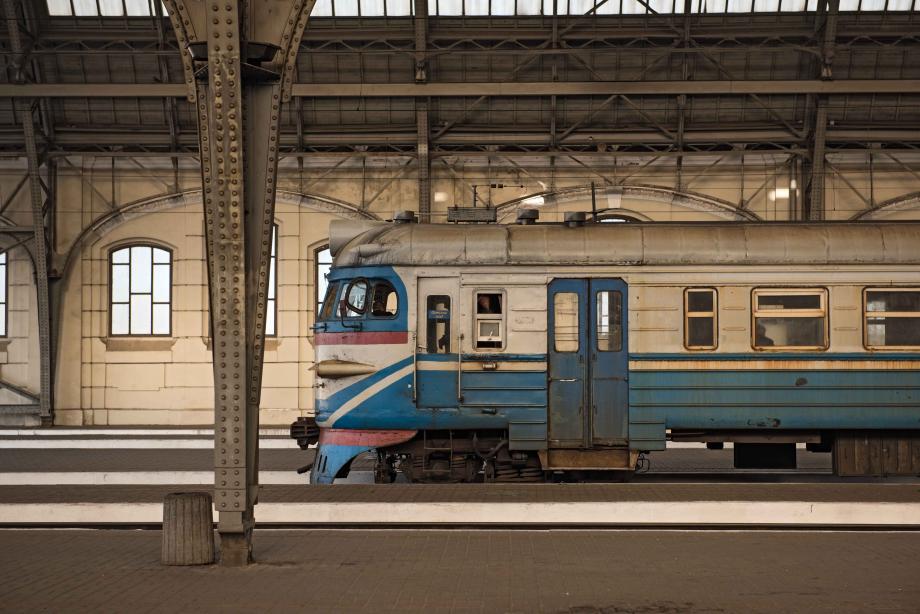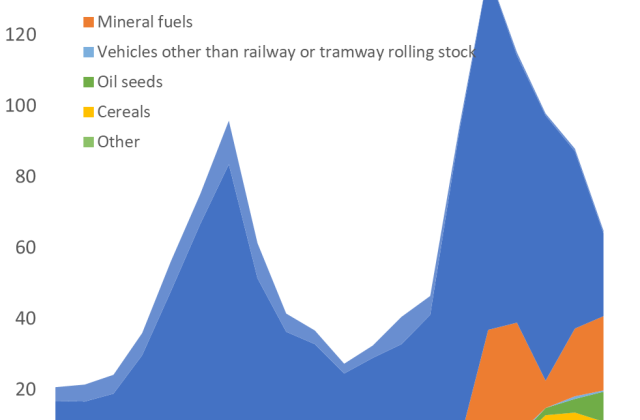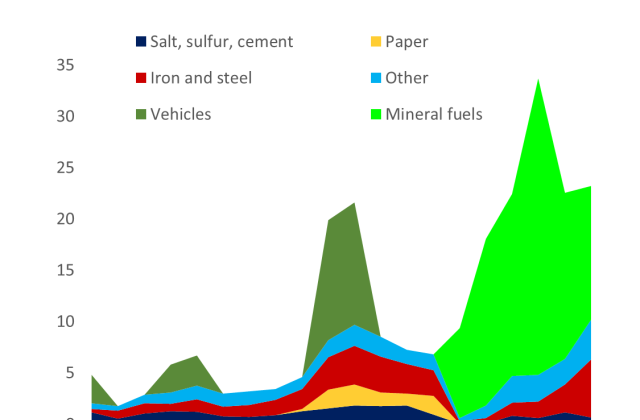Is there a solution for increasing the efficiency of the railway freight between Slovakia and Ukraine?

Railway freight transportation between Slovakia and Ukraine has natural development limitations, but the Russian aggression in Ukraine caused a significant increase in the volume of transported goods. As the threat of attack from the east continues to loom and Ukraine becomes more integrated with the European market, the number of goods exchanged between Slovakia and Ukraine will continue to grow. Slovakian businesses and railway operators should seize the opportunity to invest in expanding railway and storage infrastructure.
With the start of Russia's massive aggression against Ukraine in February 2022 and the blockage of Ukrainian seaports, the volume of goods, especially cereals, oil seeds, and mineral fuels, transported between Slovakia and Ukraine by railways has increased significantly. The railway infrastructure of both countries was not ready for such an increase in operations and the introduction of new goods. The inability to quickly process incoming trains creates queues of wagons on both sides of the border. By the end of July, more than six thousand wagons were waiting at the Chop station and around 900 wagons at the Uzhgorod station in Ukraine. This congestion creates delivery delays and decreases the stations' ability to move wagons inside the station due to limited space.
Before the war, both crossings, Maťovce to Uzhgorod and Cierna nad Tisou to Chop, specialized in iron ore, coal, wood, crude oil products, ferrous metals, machines, equipment, chemicals, and fertilizers. After Russia blockaded Ukrainian seaports in February 2022, grain and metals usually shipped by sea were re-routed to other European ports via railways. The Ukrainian-Slovakian railway route also experienced the increased transportation of "unusual" goods. Introducing new products in the logistics operation requires the special training of the personnel and the construction of specific facilities for reloading, changing wagon carts, and storing these goods. Since the stations had never dealt with grain in such volumes before, it also resulted in delays and congestion.
Freight limitations as opportunities for improvement
Some factors limit freight transportation between Slovakia and Ukraine.
First, the different widths of the railway gauge used in Slovakia (1435 mm) and Ukraine (1520 mm) require the railway operators to replace the wagon carts or to reload cargo from the wagons of one width to another. This process creates delays, costs additional money, and requires the railway operators to store enough carts for the replacement. In June 2022, the Ukrainian railway operator Ukrzaliznytsya (UZ) announced the deficit of wagon carts.
Second, Slovakia and Ukraine use different wagon widths. Ukrainian wagons are usually wider because the gauge is also broader. Therefore, their usage in Slovakia can damage railway infrastructure, such as tunnels, bridges, and platforms. Ukrainian wagons can also carry more load. The axle load of Ukrainian wagons is up to 23.5 tons, with the maximum allowable load being 18 to 20 tons in many neighbouring EU countries. Therefore, only European wagons can be used in Hungary, Slovakia, and Poland.
Third, the Slovakian railway has a lower capacity. In Ukraine, 83% of goods are transported by railway, and in the EU, only approximately 19%. In Slovakia, 20% of all goods are transported by railway. Transportation volumes are also different. In 2020, Ukraine transported 305.5 mn tonnes by railway, while Slovakia transported only 43.4 mn tonnes.[1] Thus, the Slovakian railway has fewer locomotives, wagons, locomotive brigades, customs officers, and phytosanitary inspectors, to name a few, compared to the volume that Ukraine currently wants to transport through Slovakia, judging from the queue.
Finally, the land-locked geographical location of Slovakia also limits its attractiveness for Ukrainian freight. The main destinations for Ukrainian cargo were seaports. Slovakia only has river ports on the Danube, and this route is longer and more expensive than through Moldova and the Ukrainian port of Reni. However, alternative ways have become essential, considering the high congestion on the usual routes.
These freight limitations should be treated not as unsurmountable challenges but as opportunities for improvement. Ukraine is included in the Trans-European Transport Network (TEN-T) indicative maps, and the European Commission is very much interested in increasing interoperability between the TEN-T and Ukrainian infrastructure, including through the construction of standard-gauge lines in the border regions of Ukraine. The Čierna nad Tisou station is on the TENT-T corridor as part of the Rhine-Danube Core Network Corridor, and Maťovce railway station is on the wide gauge track 104 from Uzhgorod to Košice, which is connected by track 103 to the TEN-T corridor.
The EC considers that the standard-gauge cross-border rail connections will strengthen transport connectivity between the EU and Ukraine. It will also contribute to the EC's ambition to shift 75% of road freight transport towards rail and inland waterways, thus creating a sustainable and connected transport system. Improving railway connections between Slovakia and Ukraine is part of a broader EU strategy to connect Europe and Asia. Besides improving transport infrastructure in Eastern Partnership countries, such as Armenia, Azerbaijan, Belarus, Georgia, Moldova and Ukraine, through its Indicative TEN-T Investment Plan, the strategy also includes establishing connectivity partnerships, signing air transport agreements, more interconnected regional energy platforms, increased access to digital services, and advanced cooperation in education and research. A better-connected Europe and Asia through transport links, energy, human, and digital networks will strengthen the resilience of societies and regions, facilitate trade, and bring economic prosperity to citizens.
For Slovakia, Čierna nad Tisou is an important border crossing station, accounting for one-third of the total volume of goods transported by ZSSK Cargo, Slovakia's largest freight railway company.
There is a project to restore the narrow 20-kilometre track between Chop and Uzhgorod. The route will connect Uzhgorod to Bratislava and other European cities. Laying EU standard-gauge rail lines in the border regions of Ukraine was also mentioned in the Solidarity Lanes plan. Such projects will be supported under the Connecting Europe Facility with a budget of EUR 25.81 bn for 2021 to 2027 with Slovak, Hungarian, and Polish businesses benefiting from an improved connection with Ukraine and higher throughput of railway services.
Redirecting Ukraine's grain export from seaports to railway lines could become an opportunity for third parties, such as transit states or new stakeholders like export organizations that might be attracted by rising global food prices and the possibility of constructing customs facilities.
However, the projects of constructing new railways are medium-term solutions. In the short term, the only feasible option would be to use an existing rail infrastructure and add storage facilities at the border between Slovakia and Ukraine.
Ukrzaliznytsya, backed by the Ukrainian Ministry of Economy, has called on private companies to invest and build rail freight terminals in western Ukraine. It believes that rail will be the most reliable mode of transport after the war ends. These terminals should be constructed at strategic locations near the Polish, Slovak, Hungarian, and Romanian borders.
Recommendations for railway authorities
· Prolonging the tracks of 1435 mm width further into Ukrainian territory and tracks of 1520 mm further into the Slovakian territory would provide more space and flexibility to build reloading and cart-replacing facilities. There is an existing Uzhgorod-Kosice broad-gauge track used predominantly for transporting iron ore to the U.S. Steel Košice steel plant. However, more tracks should be built, including narrow-gauge tracks in Ukraine.
There is strong support for developing narrow gauge rail lines among Ukrainian businesses. The Ukrrudprom association of miners suggested building combined lines, as seen in border towns of Sweden and Finland, in which two types of tracks are laid simultaneously on the same line.
Ukrainian Deputy Minister of Finance Oleksandr Kava, who oversees the financing of infrastructure projects, noted that "it is quite realistic and expedient to develop cross-border corridors with the European gauge, as well as to use the existing infrastructure of the 1,435 mm gauge, which has not been used for a long time, to build new sections of the European gauge to large cities in the regions bordering the EU. Definitely, it is necessary to move in this direction." There are large sections of the European gauge in Ukraine from Chop to Mukachevo and Diakovo. Last year, project documentation was prepared to restore the passage of the European gauge from Chop to Uzhgorod and create a freight and passenger hub in Uzhgorod.
· The introduction of a special CIM/SMGS consignment note will speed up the process of crossing the border and enable more straightforward, acceptable, and faster transport by rail. Ukraine and Slovakia use different transport rules, SMGS and CIM, respectively.
Combining the consignment notes for each set of rules means that both contracts for carriage can be displayed on a single sheet of paper that can be issued electronically. Transport through the Slovak Railways is to be regulated by the rules of the CIM until the border station, where the rules concerning SMGS for further transport in Ukraine will be applied, and vice versa. This will provide greater legal certainty for all participants in the transportation process, reduce transportation costs and time, improve the quality of transport, and provide greater competitiveness for railways in international freight.
The introduction of electronic combined CIM/SMGS consignment notes will save 66.7% of the total time spent at border stations.
· A common online information and order tracking system will also allow the operators on both sides of the border to prepare for coming shipments and warn about arising complications.
Recently, the Ukrainian railway operator Ukrzaliznytsya has offered access to its freight order system Mesplan to its Slovakian partners. ZSSK Cargo is already testing the service, and other Slovakian carriers should do the same.
Recommendations for business
· To construct additional storage facilities on the Ukrainian border.
Ukrainian maritime routes will remain limited or congested in the nearest future. Thus the demand for storage facilities, especially agricultural products, will remain high.
Railways will become essential for fuel supplies to Ukraine after the war. The current situation, where a significant portion of the fuel is delivered to Ukraine by car tankers and then distributed directly to petrol stations in that country, bypassing fuel bases, is inefficient and not profitable due to the relatively high truck freight costs. Therefore, there will be a demand for new fuel terminals with access to the railways.
The development of logistics complexes in Mukachevo, Chop, and Kosice will turn Ukraine and Slovakia into a gate between Asia and Europe in line with the EU strategy and into one central logistics hub.
Building terminals and other infrastructure on the Slovak-Ukrainian border will increase demand for complimentary services and spur economic activity in the East Slovakia region.
Railway services will be essential for the post-war recovery of Ukraine. The large-scale reconstruction of Ukrainian cities will require rail and other modes of transportation to deliver construction materials, restore supplies to the formerly occupied territories, and export Ukrainian products to the world. Therefore, enhancing the Slovak-Ukrainian railway connection will effectively contribute to Ukraine's restoration and further economic integration into the EU.
[1] The latest available data for Slovakia is 2020. For Ukraine, more recent data is available. In 2021, Ukraine transported by railway 314.3 mn tonnes.


